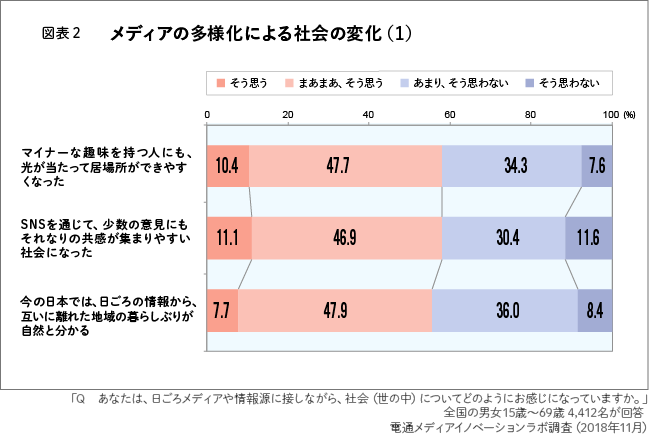Dentsu Inc. Media Innovation Lab published the "Information Media White Paper 2019" in February. This year's opening feature, "30 Years of Heisei: The Evolution and Innovation of Information Media," looks back at the media's journey to the present using long-term data.
In the first installment of this series, we examined the phenomenon of "earlier bedtimes among younger generations" that emerged from reanalyzing long-term data, pointing out its potential as an unexpected factor driving changes in young people's media consumption behavior.
This second installment conveys the thoughts and perspectives embedded in PART 1 of the opening feature, "The Transformation of Media Consumption Behavior and Prospects for a 'Rich Media Society'," along with insights for interpreting it.
What is a "Rich Media Society"?
First, regarding the term "rich media society." This name embodies a positive concept: the societal conditions brought about by the addition of the spread and evolution of the internet since the 1990s to the traditional media used since before the Heisei era, which has fostered the discovery, exchange, and sharing of new value.
The opening feature of this book compiles various topics surrounding media that emerged during the 30 years of the Heisei era into a timeline. Looking back over these three decades, it becomes clear that diverse phenomena and trends have manifested themselves through media.
Many of these phenomena and trends occurred on new media platforms. Recent examples include "PPAP" by Pikotaro (2016), which set a world record for YouTube views at the time, and "Instagrammability" (2017), a behavior now firmly established among young people.
Figure 1 shows the trend in daily contact rates for major media over the 20-year period from 1998 to 2018. As is immediately apparent, internet contact has consistently increased over these two decades. As the variety of services has expanded, the internet has increasingly served as the source for new trend phenomena like the examples mentioned earlier, and as a cradle for sharing and spreading new values.
As internet usage has expanded, activities and subjects that were previously considered somewhat niche and had few opportunities to gain broad social recognition have increasingly come into the spotlight and attracted attention, influencing lifestyle choices, hobbies, and even values.
Moreover, it's not just about gaining broad social recognition; people with shared interests and concerns can now find new spaces online where they connect beyond geographical and temporal constraints. Many seem to sense this change (Figure 2).
Of course, numerous troubles and incidents have also arisen due to this convenience. Nevertheless, we believe that in this sense, the media society of the 30-year Heisei era can be said to have become "richer" overall.
Confusion and Challenges Toward a "Rich Media Society" in the Post-Heisei Era
In contrast to the ability to find favorite places within the online space and enjoy pleasant times and experiences, society has also become one where "discommunication" and "intolerance" towards those with even slightly different perspectives are increasingly noticeable, leading to the identification of numerous challenges.
For instance, a significant majority of people report feeling that the increase in information has made it harder to discern the average public opinion, that they are increasingly exposed to information unrelated to themselves, and that finding common ground for conversation has become more difficult (Figure 3).
Viewed this way, we can see how the "richness" gained through the widespread adoption of the internet coexists with a sense of "confusion" that seems to be its flip side.
Against this backdrop, this issue's lead feature traces the gaps in media consumption behaviors across generations during the rapidly changing 30 years of the Heisei era using data. For example, it highlights how even among young people, those in their teens are adopting new media consumption patterns distinct from those in their twenties and older.
Furthermore, the feature explains this phenomenon—where differences in media engagement emerge between generations as members of the same cohort age alongside the "new" media they were passionate about in their youth—from the perspective of "carry-over of generational characteristics," and offers projections for the future.
Moving forward, starting next time, this series will link with the 'Information Media White Paper 2019'. We will trace back the origins of communication styles, content consumption patterns, and information behaviors that have quietly permeated our daily lives over the 30 years of the Heisei era and are now accepted as commonplace through media. Please look forward to it.





